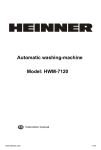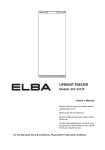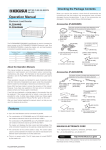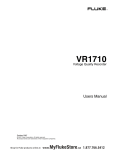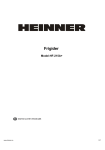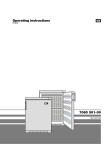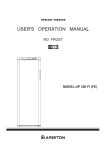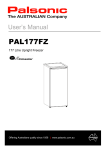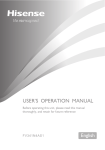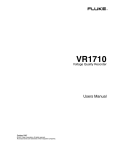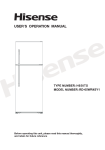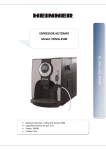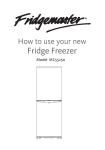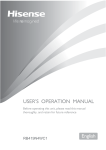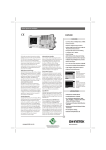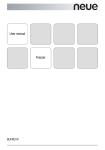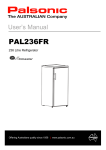Download Freezer - Heinner
Transcript
Freezer Model:HFF-160A+ EN User manual www.heinner.com 1/12 Contents Safety and warning information_ __ _ _ _ _ 2 Helpful hints and tips _ _ _ _ _ _ _ _ _ _ _ 7 Description of the appliance!_ _ _ _ _ _ _ _ 4 Cleaning and care _ _ _ _ _ _ _ _ _ _ _ _ 8 What to do if_ _ _ _ _ _ _ _ _ _ _ _ _ _ _ _ 9 Control panel _ _ _ _ _ _ _ _ _ __ _ _ _ _ _ 4 First use and installation_ _ _ _ _ _ _ _ _ _ 6 Daily use __ _ _ _ _ _ _ _ _ _ __ _ _ _ _ _ 7 Reversing the door _ _ _ _ _ _ _ _ _ _ _ 10 Disposal of the appliance _ _ _ _ _ _ _ _ 12 This appliance is in accordance with the following EU guidelines: 2006/95/EC and 2004/108/EC and 2009/125/EC and EC.643/2009. Safety and warning information For your safety and correct usage, before installing and first using the appliance, read this user manual carefully, including its hints and warnings. To avoid unnecessary mistakes and accidents, it is important to make sure that all people using the appliance are thoroughly familiar with its operation and safety features. Save these instructions and be sure that they remain with the appliance if it is moved or sold, so that a using it throughout its life will be properly informed on its correct appliance usage and safety. For the safety of life and property, keep the precautions of these user's instructions as the manufacturer is not responsible for damages caused by omission. Safety for children and others who are vulnerable people This appliance is not intended for use by persons (including children) with reduced physical, sensory or mental capabilities, or a lack of experience and knowledge, unless they have been given supervision or instruction concerning the use of the appliance by a person responsible for t h e i r s a f e t y. C h i l d r e n s h o u l d b e supervised to ensure that they do not play with the appliance. Keep all packaging away from children as there is risk of suffocation. If you are discarding the appliance, pull the plug out of the socket, cut the www.heinner.com connection cable (as close to the appliance as you can) and remove the door to prevent children playing from suffering an electric shock or from closing themselves inside it. If this appliance, featuring a magnetic door seals, is to replace an older appliance having a spring lock (latch) on the door or lid, be sure to make the spring lock unusable before you discard the old appliance. This will prevent it from becoming a death trap for a child. General safety Caution! Keep ventilation openings clear of obstructions. The appliance is intended for keeping food and/or beverages in a normal household as explained in this instruction manual. Do not use a mechanical device or any artificial means to speed up the thawing process. Do not use other electrical appliances (such as ice cream makers) on the inside of refrigerating appliances, unless they are approved for this purpose by the manufacturer. Do not damage the refrigerant circuit. The refrigerant isobutane (R600a) is contained within the refrigerant circuit of the appliance. It is a natural gas with a high level of environmental compatibility, which is nevertheless flammable. 2/12 Caution: Risk of fire! During the transportation and installation of the appliance, make certain that none of the components of the refrigerant circuit become damaged. -avoid open flames and sources of ignition. -thoroughly ventilate the room in which the appliance is located. It is dangerous to alter the specifications or modify this product in any way. Any damage to the cord may cause a shortcircuit, fire, and/or electric shock. Warning! Any electrical component (power cord, plug, compressor) must be replaced by a certified service agent or qualified service personnel. 1. The power cord must not be lengthened. 2. Make sure that the power plug is not crushed or damaged. A crushed or damaged power plug may overheat and cause a fire. 3. Make sure that you can access the main plug of the appliance. 4. Do not pull the main cable. 5. If the power plug socket is loose, do not insert the power plug. There is a risk of electric shock or fire. 6. You must not operate the appliance without the interior lighting lamp cover. Daily use Do not remove nor touch items from the freezer compartment if your hands are damp/wet, as this could cause skin abrasions or frost/freezer burns. Do not place the appliance in direct sunlight. Do not store flammable gases or liquids inside the appliance. There is a risk of an explosion. Do not operate any electrical appliances within the appliance (e.g. electric ice cream makers, mixers, etc.). When unplugging, always pull the plug from the main outlet. Do not pull on the cord. Do not place hot items near the plastic components of this appliance. Do not place food products directly against the air outlet on the rear wall. 1) Frozen food must not be refrozen once it has been thawed out. 2) www.heinner.com Store pre-packaged frozen food in accordance with the frozen food manufacturer's instructions. 2) The appliance's manufacturing storage recommendations should be strictly adhered to. Refer to the relevant instructions for storage. Do not place carbonated or fizzy drinks in the freezer compartment as it creates pressure on the container, which may cause it to explode, resulting in damage to the appliance. 2) Ice lollies (popsicles) can cause frost burns if consumed straight from the refrigerated compartment. 2) Do not store explosive substances such as aerosol cans with a flammable propellant in this appliance. This appliance is intended to be used in household and similar applications such as -staff kitchen areas in shops, offices and other working environments; -farm houses and by clients in hotels, motels and other residential type environments; -bed and breakfast type environments; -catering and similar non-retail applications Keep burning candles,lamps and other items with naked flames away from the appliance so that do not set the appliance on fire. Warning! Care and cleaning Before maintenance, switch off the appliance and disconnect the main plug from the main outlet. Do not clean the appliance with metal objects, steam cleaners, ethereal oils, organic solvents or abrasive cleansers. Do not use sharp objects to remove frost from the appliance. Important! Installation For electrical connection, carefully, follow the instructions given in this manual. Unpack the appliance and check if there is damages to it. Do not connect the appliance if it is damaged. Report possible damages immediately to the location where you purchased it. In this case, retain all packing materials. It is advisable to wait at least four hours before connecting the appliance to allow the refrigerant to flow back into the compressor. 3/12 Adequate air circulation should be around the appliance, as a lack of this leads to overheating. To achieve sufficient ventilation, follow the instructions relevant to the installation. Wherever possible, the back of the product should be against a wall to avoid touching or catching warm parts (compressor, condenser), and to prevent the risk of fire, follow the instructions relevant to installation. The appliance must not be located close to radiators or cooking appliances. Make sure that the main plug is accessible after installation of the appliance. Service Any electrical work required to do the servicing of the appliance should be carried out by qualified electrician or authorized person. This product must be serviced by an authorized Service Center, and only genuine spare parts must be used. 1) If the appliance is Frost Free. 2) If the appliance contains a freezer compartment. Description of the appliance 1 View of the appliance 1. Control panel 2 2. Upper drawer 3. Drawers 7 4. Ice tray (inside) 5. Lower drawer 3 6. Adjustable feet 7. Door 4 5 6 Note: Due to unceasing modification of our products your refrigerator may be slightly different from this Instruction Manual, but its functions and using methods remain the same. Control panel Normal Min Max The thermostat control situated in the control panel regulates the temperature of the freezer compartment. Position“MIN”–Cold. Position“NORMAL”–Colder normally, setting at this position. Position“MAX”–Coldest. The temperature will be affected by: Room temperature How often the door is opened How much food is stored Position of the appliance www.heinner.com In determining the correct temperature control setting, all these factors have to be considered and some experimentation may be necessary. Do not allow children to tamper with the controls or play with the product. Important!-Normally we advise you select setting of “Normal”, if you want the temperature higher or lower please turn the knob to Warmer or colder setting accordingly. 4/12 When you turn the knob to colder which can lead to the more energy efficiency. Otherwise, it would result the energyconsuming. Important!-High ambient temperatures (e.g. on hot summer days) and a cold setting on the temperature regulator (position “Max”) can cause the compressor to run continuously or even non-stop! Reason: when the ambient temperature is high, the compressor must run continuously to maintain the low temperature in the appliance. The freezer compartment The symbol means that your freezer will store frozen food at -18°C(-0.4F) or colder allowing for long term frozen-food storage and freezing of fresh food. The freezer temperature is controlled automatically by the thermostat situated in the control panel. Due to the different installations, methods of usage and weather conditions, adjustments to the temperature settings may be required. These are best assessed against a temperature reading on a thermometer buried in the frozen food. The reading must be taken quickly as the thermometer temperature will rise rapidly after removal. Freezing fresh food Briefly set the knob to the Max position.The freezer temperature drops,the appliance operates with the maximum refrigerator capacity. In case of a small amount food to be frozen,please wait about 4h; In case of the maximum amount food to be frozen(see rating label),please wait about 24h. The appliance continues to operate in the energy-saving, please set the knob to the normal position。 Place the fresh food in the top freezer drawer. Food may need rearranging to achieve this. During the freezing process the temperature of fresh food should be reduced quickly so that ice crystals are kept as small as possible to avoid damaging the structure of food. If freezing takes place slowly large www.heinner.com ice crystals form and these will affect the quality of food once it has defrosted.Existing frozen food should be rearranged to leave space in the top two drawers for freezing. The packets to be frozen should be placed in the drawer in contact with the drawer surface as far as possible and spaced apart to allow cold air to circulate between them. They should not touch existing packets. If there is enough room, transfer the food you have frozen to the baskets or drawers to allow you to freeze a further load in the top drawer. Exceptionally large items can be stored by removing the drawer. Frozen food should not be refrozen once it has thawed out. Do not remove items from the freezer if your hands are damp/wet, as this could cause skin abrasions or “frost/freezer burns”.For safety reasons, the freezer drawer are fitted with stops but are readily removed by pulling them forward to the stop, then lifting the front and pulling all the way out. Refit by reversing this procedure. Frozen food storage Pre-packed commercially frozen food should be stored in accordance with the manufacturer's instructions for a 4 star frozen food compartment and should be put in the freezer as soon as possible after purchase. Your freezer provides for long term storage which generally means up to 3 months but the length of the time can vary and it is important to follow the recommended times shown on packets of commercially frozen food. Do not place sealed containers or carbonated liquids such as fizzy drinks into the freezer as it creates pressure on the container which may cause it to explode leading to damage to the freezer. Ice cubes and ice lollies should not be consumed immediately after removal from the freezer as it may result in low temperature skin abrasions. 5/12 First use and installation Cleaning before use Before using the appliance for the first time, wash the interior and all internal accessories with lukewarm water and neutral soap in order to remove the typical smell of a brand new product, then dry thoroughly. Installation Positioning Warning! Before installing, read the instructions carefully for your safety and the correct operation of the appliance. Position the appliance away from sources of heat such as stoves, radiators, direct sunlight, etc. Maximum performance and safety are guaranteed by maintaining the correct indoor temperature for the class of unit concerned, as specified on the rating plate. This appliance performs well from N to ST. The appliance may not work properly if it is left for a longer period at a temperature above or below the indicated range. Important! It is necessary to have good ventilation around the freezer to allow for the dissipation of heat, high efficiency,and low power consumption. For this reason, sufficiently cleared space should be available around the freezer. It is advisable for there to be 75mm separating the back of the freezer to the wall at least 100mm of space on its two sides, a height of over 100mm from its top and a clear space in front to allow the doors to open 160°. Climate class Ambient temperature SN +10°C to +32°C N +16°C to +32°C ST +16°C to +38°C T +16°C to +43°C Appliances must not be exposed to rain. Sufficient air must be allowed to circulate in the lower rear section of the appliance, as poor air circulation can affect performance. Built-in appliances should be positioned away from heat sources such as heaters and direct sunlight. Leveling The appliance should be level in order to eliminate vibration. To make the appliance level, it should be upright and both adjusters should be in stable contact with the floor. You can also adjust the level by unscrewing the appropriate level adjustment in the front (use your fingers or a suitable spanner). Electrical connection Caution! Any electrical work required to install this appliance should be carried out by a qualified or authorized person. Warning!This appliance must be grounded. The manufacturer declines any liability should these safety measures not be observed. 100mm 75mm 100mm www.heinner.com 6/12 Daily use Accessories 1) Freezer Drawer For storing frozen food. Ice-cube tray For making ice and storing ice-cubes. Freezer food compartment 2) For freezing fresh food and storing frozen and deep-frozen food for long periods of time. Thawing food 2) In the freezer compartment. At room temperature. In a microwave oven. In a conventional or convection oven. Food once thawed should be re-frozen with the exception of special cases. 1) If the appliance contains related accessories and functions. 2) If the appliance contains a freezer compartment. Helpful hints and tips Noises during operation Clicks- Whenever the compressor switches on or off, a click can be heard. Humming- As soon as the compressor is in operation, you can hear it humming. Bubbling- When refrigerant flows into thin tubes, you can hear bubbling or splashing noises. Splashing- Even after the compressor has been switched off, this noise can be heard for a short time. Energy saving tips Do not install the appliance near stoves, radiators or other sources of warmth. Keep the time the appliance is open to a minimum. Do not set the temperature colder than necessary. Make sure the side plates and back plate of the appliance are at some distance from the wall, and follow the instructions relevant to installation. If the diagram shows the correct combination for the drawers, crisper and shelves, do not adjust the combination as it would produce an effect on energy consumption. Prepare food in small portions to enable it to be rapidly and completely frozen and to make it possible to subsequently thaw only the quantity required. Wrap up the food in aluminum foil or polyethylene (plastic) and make sure that the packages are airtight. Do not allow fresh, unfrozen food to touch food that is already frozen, thus avoiding a rise in the temperature of the latter. Iced products, if consumed immediately after removal from the freezer compartment, can possibly cause skin to become freezer burnt. It is recommended to label and date each frozen package in order to keep track of the storage time. Hints for the storage of frozen food Make sure that commercially frozen food was stored by the retailer. Once defrosted, foods deteriorate rapidly and can not be re-frozen. Do not exceed the storage period indicated by the food manufacturer. Note: If the appliance contains related accessories and functions. Hints for freezing When first starting-up or after a period out of use. Before putting the food in the compartment, let the appliance run at least 2 hours on the higher settings. www.heinner.com 7/12 Cleaning and Care Cleaning and care For hygienic reasons, the appliance interior, including interior accessories, should be cleaned regularly. The appliance should be cleaned and maintained at least every two months. Warning! Danger of electrical shock! The appliance should not be connected to the main power supply during cleaning. Before cleaning, switch the appliance off and remove the plug from the main power supply, switch off, or shut off the circuit breaker or fuse. Notice! Remove the food from the appliance before cleaning. Store them in a cool place and keep well covered. Never clean the appliance with a steam cleaner. Moisture could accumulate in electrical components. Hot vapors can lead to the damage of plastic parts. Ethereal oils and organic solvents can attack plastic parts, e.g. lemon juice or the juice from an orange peel, butyric acid,or cleansers that contain acetic acid. Do not allow such substances to come into contact with appliance parts. Do not use any abrasive cleansers. Clean the appliance and the interior accessories with a cloth and lukewarm water. Commercially available dish washing detergents may also be used. After cleaning, wipe with fresh water and a clean dish cloth. Accumulation of dust at the condenser increases energy consumption; clean the condenser at the back of the appliance once a year with a soft brush or a vacuum cleaner.(Only for the outside-condenser product) Check the water drain hole on the rear wall of the refrigerator compartment. Clear a blocked drain hole with the aid of something like soft green peg, an be careful not to create any damage to the cabinet by sharp objects. After everything is dry, the appliance back into service. www.heinner.com Defrosting Defrosting in the frozen food storage compartment Defrosting in the freezer chamber is operated manually. Before defrosting, take the food out. Take the ice tray and drawers out or put them into the fresh food compartment temporarily. Leave the door of the refrigerator open until ice and frost dissolve thoroughly and accumulate at the bottom of the freezer chamber. Wipe out the water with the soft cloth. In order to speed up the process of defrosting, you may put a bowl of warm water (about 50°C) into the freezer chamber and scrape away the ice and frost with a defrosting spatula. After doing so, be sure to set the knob of the temperature regulator to the original position. It is not advisable to heat the freezer chamber directly with hot water or a hair dryer while defrosting to avoid deformation of the inner case. It is also not advisable to scrape off ice and frost or separate foods from the containers which have been congealed together with the food with sharp tools or wooden bars, so as not to damage the inner casing or the surface of the evaporator. Notice! The appliance should be defrosted at least once a month. During its usage, if the door has been opened frequently the appliance has been used in extreme humidity, we advise the user to defrost every two weeks. Taking the appliance out of service Empty the appliance. Pull out the power plug. Clean thoroughly (see section: Cleaning and Care). Leave the door open to prevent odours. 8/12 What to do if… Warning! Before trouble-shooting, disconnect the power supply. Only a qualified electrician or other personnel must carry out the troubleshooting that is not in the manual. Problem Appliance does not work. Important! Repairs to the appliance may only be performed by competent service engineers. Improper repairs can give rise to significant hazards for the user. If your appliance needs repairing, please contact your specialist dealer or your local Customer Service Center. Possible cause Appliance is not switched on. Solution Main plug is not plugged in or is loose. Plug the appliance into the electrical socket. Fuse has blown or is defective. Check fuse, replace if necessary. Defective parts need to be repaired by an electrician. Turn the temperature regulator to a warmer setting temporarily. Outlet is defective. Appliance cools too much. Temperature is set too cold. Switch on the appliance. Temperature is not properly adjusted. Please refer to the “Initial Start Up” section. Door was open for an extended period. Open the door only as long as necessary. A large quantity of warm food was placed in the appliance within the last 24 hours. Turn the Control panel to a colder setting temporarily. The appliance is near a heat source. Please refer to the “Installation Location” section. Interior lighting does not work. Light bulb is defective. Please look in the “Changing the Light Bulb “section. Heavy build-up of frost, possibly also on the door seal. Door seal is not air-tight (possibly after reversing the door). Carefully warm the leaking sections of the door seal with a hair dryer (on a cool setting). At the same time, shape the warmed door seal by hand so that it sits correctly. Appliance is not level. Readjust the feet. The appliance is touching the wall or other objects. Move the appliance slightly. A component, e.g. a pipe, on the rear of the appliance is touching another part of the appliance or the wall. If necessary, carefully bend the component out of the way. This is normal, no error has occurred. The compressor starts after a period of time. Water drain hole is blocked. Refer to the “Cleaning and Care” section. The food is too warm. Unusual noises. The compressor does not start immediately after changing the temperature setting. Water on the floor or www.heinner.com storage shelves. 9/12 Reverse the door The side in which the door opens can be changed from the right side (as supplied) to 3. Use a flat bladed screw driver to remove the front ornament of top cover plate. the left side, if the installation site allows for it. Tools you will need: 1. 8mm socket driver 2. Cross-shaped screwdriver 4. Replace the front ornament of top cover plate in the other side. 3. Putty knife or thin-blade screwdriver 1. Stand the freezer, use a flat bladed screw driver to remove the 4 screw covers at the rear of the freezer lid. 2. Unscrew and lift the lid from the rear and remove it, then lift the upper door and place it on a padded surface to prevent it scratched. www.heinner.com 5.Remove the upper hinge core, transfer it to left side and tighten securely, then put it in a safe place. 6. Remove both adjustable feet and the bottom hinge bracket by unscrewing the bolts. 10/12 7. Unscrew and remove the bottom hinge pin, turn the bracket over and replace it. Refit the bracket fitting the bottom hinge pin. Replace both adjustable feet. Transfer the lower door to the property position. Secure the door's level, make the bottom hinge pin into the lower hole of the door, then tight the bolts. When you reverse the door, Please do : 1. Move the accessory B from the upper cover of the upper door and fit the accessory A that is a small detachable part from a small bag. A B 8.Replace the lid by fitting the upper hinge core into the upper door’s hole, securing it with the 4 screws.Replace the screw covers. Warning! When changing the side at which the door opens, the appliance must not be connected to the mains. Remove plug from the mains beforehand. www.heinner.com 11/12 Disposal of the appliance It is prohibited to dispose of this appliance in domestic household waste. Packaging materials Packaging materials with the recycle symbol are recyclable. Dispose of the packaging in a suitable waste collection container to recycle it. Before disposal of the appliance. 1. Disconnect the main plug from the main socket. 2. Cut off the main cable and discard it. Correct disposal of this product This symbol on the product, or in its packaging, indicates that this product may not be treated as household waste. Instead, it should be taken to the appropriate waste collection point for the recycling of electrical and electronic equipment. By ensuring this product is disposed of correctly, you will help prevent potential negative consequences for the environment and human health, which could otherwise be caused by the inappropriate waste handling of this product. For more detailed information about the recycling of this product, please contact your local council, your household waste disposal service, or the shop where you purchased the product. HEINNER is a registered trademark of Network One Distribution SRL. Other brands and product names are trademarks or registered trademarks of their respective holders. No part of the specifications may be reproduced in any form or by any means or used to make any derivative such as translation, transformation, or adaptation without permission from NETWORK ONE DISTRIBUTION. This product is in conformity with norms and standards of European Community Importer: Network One Distribution Europolis Logistic Park, Italia Street, 1-7, Chaijna, Ilfov, Romania Tel: +40 21 211 18 56, www.heinner.com , www.nod.ro www.heinner.com 12/12












